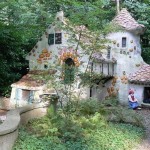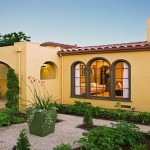House plans with in-law suites, also called accessory dwelling units (ADUs), are a type of home design that includes an attached or detached living space intended for extended family members or elderly individuals who require additional care. These suites typically feature a separate entrance, bedroom, bathroom, and kitchenette, offering privacy and independence while maintaining close proximity to the main house.
In-law suites are growing in popularity as families seek more flexible living arrangements. They can provide a comfortable and affordable option for aging parents who need assistance but prefer not to live in a nursing home. They can also accommodate adult children who are returning home after college or military service or those who simply desire a more independent living situation.
In the following sections, we will explore the various types of house plans with in-law suites, their advantages and disadvantages, and the key considerations for designing and building this type of home.
When considering house plans with in-law suites, there are several key points to keep in mind:
- Provide separate entrance
- Include private bedroom
- Incorporate private bathroom
- Consider small kitchenette
- Ensure handicap accessibility
- Design for aging in place
- Consider proximity to main house
- Plan for privacy and sound insulation
- Consult local building codes
- Involve family members in planning
By carefully considering these points, you can create a house plan with an in-law suite that meets the needs of your family and provides a comfortable and independent living space for your loved ones.
Provide separate entrance
A separate entrance is essential for an in-law suite to provide privacy and independence for both the occupants of the suite and the main house. It allows the in-laws to come and go as they please without having to go through the main house, and it gives them their own space to entertain guests or pursue hobbies.
- Separate door: The separate entrance should have its own door, preferably one that is accessible from the outside and does not require going through the main house.
- Private walkway: If possible, the separate entrance should have its own private walkway or path leading to it, so that the in-laws do not have to walk through the main yard or driveway to get to their suite.
- Designated parking: If there is room on the property, it is a good idea to designate a parking space for the in-laws near their separate entrance.
- Security features: The separate entrance should be well-lit and have security features such as a deadbolt lock and peephole.
By providing a separate entrance for the in-law suite, you can create a more comfortable and independent living space for your loved ones.
Include private bedroom
A private bedroom is essential for an in-law suite to provide privacy and independence for the occupants. It should be a comfortable size and have enough space for a bed, dresser, and other furniture. It should also have a window to provide natural light and ventilation.
- Adequate size: The bedroom should be large enough to accommodate a bed, dresser, and other furniture comfortably. A good rule of thumb is to allow for at least 100 square feet of space.
- Natural light: The bedroom should have at least one window to provide natural light and ventilation. This will help to create a more comfortable and inviting space.
- Privacy: The bedroom should be located in a private area of the suite, away from any common areas. This will help to ensure that the occupants have privacy and can sleep soundly.
- Accessibility: The bedroom should be easily accessible from the other rooms in the suite, including the bathroom and kitchen.
By providing a private bedroom for the in-law suite, you can create a more comfortable and independent living space for your loved ones.
Incorporate private bathroom
A private bathroom is essential for an in-law suite to provide privacy and independence for the occupants. It should be a full bathroom with a toilet, sink, and shower or bathtub. It should also be accessible from the bedroom and have adequate space for the occupants to move around comfortably.
- Full bathroom: The bathroom should include a toilet, sink, and shower or bathtub. A full bathroom will provide the occupants with the privacy and convenience they need.
- Accessible from bedroom: The bathroom should be accessible directly from the bedroom, without having to go through any other rooms. This will provide the occupants with easy access to the bathroom, especially at night or in an emergency.
- Adequate space: The bathroom should be large enough for the occupants to move around comfortably. It should have enough space for a toilet, sink, and shower or bathtub, as well as some storage space for toiletries and other items.
- Privacy: The bathroom should be located in a private area of the suite, away from any common areas. This will help to ensure that the occupants have privacy when using the bathroom.
By incorporating a private bathroom into the in-law suite, you can create a more comfortable and independent living space for your loved ones.
Consider small kitchenette
A small kitchenette is a great way to provide the occupants of an in-law suite with the convenience of being able to prepare their own meals and snacks without having to go into the main house. It can also be a great space for them to entertain guests or pursue hobbies. When designing a kitchenette, it is important to consider the following:
- Size: The kitchenette should be large enough to accommodate a small refrigerator, sink, and microwave. It should also have enough counter space for food preparation and storage.
- Appliances: The kitchenette should include a small refrigerator, sink, and microwave. A toaster oven or hot plate can also be added for additional cooking options.
- Storage: The kitchenette should have enough storage space for food, cookware, and dishes. This can be achieved with cabinets, drawers, and shelves.
- Layout: The kitchenette should be laid out in a way that is efficient and easy to use. The refrigerator, sink, and microwave should be placed in close proximity to each other to minimize movement.
By carefully considering these factors, you can create a small kitchenette that is both functional and convenient for the occupants of the in-law suite.
In addition to the above considerations, it is also important to think about the overall design of the kitchenette. It should be designed to complement the style of the in-law suite and the main house. The use of natural materials, such as wood and stone, can create a warm and inviting space. The use of bright colors and ample lighting can make the kitchenette feel more spacious and inviting.
By following these tips, you can create a small kitchenette that is both functional and stylish, and that will provide the occupants of the in-law suite with the convenience and independence they need.
Ensure handicap accessibility
If the in-law suite is intended for an elderly or disabled person, it is important to ensure that it is handicap accessible. This means that the suite should be designed to accommodate the needs of individuals with mobility impairments, visual impairments, or other disabilities. The following are some key considerations for ensuring handicap accessibility in an in-law suite:
- Wide doorways: All doorways in the suite should be at least 32 inches wide to allow for easy passage of wheelchairs and other mobility devices.
- Ramp access: If the suite is located on a raised level, a ramp should be installed to provide access for wheelchairs and other mobility devices.
- Non-slip flooring: The flooring in the suite should be non-slip to prevent falls.
- Grab bars: Grab bars should be installed in the bathroom and near the toilet to provide support for individuals with mobility impairments.
- Accessible shower: The shower should be accessible to individuals with mobility impairments. This can be achieved by installing a roll-in shower or a shower with a bench seat.
- Raised toilet: The toilet should be raised to a height that is comfortable for individuals with mobility impairments.
- Accessible kitchen: The kitchen should be designed to be accessible to individuals with mobility impairments. This can be achieved by installing lower countertops, pull-out shelves, and other accessible features.
- Assistive technology: Assistive technology, such as voice-activated controls and automatic door openers, can be installed to make the suite more accessible for individuals with disabilities.
By carefully considering these factors, you can create an in-law suite that is both comfortable and accessible for individuals with disabilities.
Design for aging in place
When designing an in-law suite, it is important to consider the possibility of the occupants aging in place. This means designing the suite in a way that will allow them to continue to live independently and safely as they age. The following are some key considerations for designing an in-law suite for aging in place:
- Universal design: Universal design is a design approach that creates spaces that are accessible and usable by people of all ages and abilities. When designing an in-law suite for aging in place, it is important to incorporate universal design principles, such as wider doorways, lever handles, and non-slip flooring.
- Safety features: Safety features, such as grab bars, ramps, and non-slip flooring, can help to prevent falls and other accidents. It is important to install these features throughout the suite, especially in the bathroom and kitchen.
- Assistive technology: Assistive technology, such as voice-activated controls and automatic door openers, can make it easier for elderly or disabled individuals to live independently. When designing an in-law suite, it is important to consider the potential need for assistive technology and to incorporate features that will make it easy to install and use.
- Future-proofing: When designing an in-law suite, it is important to think ahead and consider the future needs of the occupants. For example, it is a good idea to install a roll-in shower or a shower with a bench seat, even if the occupants do not currently need these features. This will make it easier for them to age in place in the future.
By carefully considering these factors, you can create an in-law suite that is both comfortable and safe for elderly or disabled individuals to live in. This will allow them to maintain their independence and quality of life as they age.
Consider proximity to main house
The proximity of the in-law suite to the main house is an important consideration. There are several factors to consider when determining the ideal proximity, including the level of independence desired by the occupants of the suite, the need for privacy, and the frequency of interaction between the occupants of the suite and the main house.
If the occupants of the in-law suite desire a high level of independence, it may be best to locate the suite at a greater distance from the main house. This will give them more privacy and a greater sense of autonomy. However, if the occupants of the suite require regular assistance or supervision, it may be best to locate the suite closer to the main house. This will make it easier for the occupants of the main house to provide the necessary assistance.
The frequency of interaction between the occupants of the suite and the main house is another important consideration. If the occupants of the suite plan to spend a lot of time interacting with the occupants of the main house, it may be best to locate the suite closer to the main house. This will make it easier for them to socialize and participate in family activities. However, if the occupants of the suite prefer to have more privacy and separation, it may be best to locate the suite at a greater distance from the main house.
Ultimately, the best way to determine the ideal proximity of the in-law suite to the main house is to consider the specific needs and preferences of the occupants of both the suite and the main house. By carefully considering these factors, you can create a living arrangement that meets the needs of everyone involved.
Plan for privacy and sound insulation
Privacy and sound insulation are important considerations when designing an in-law suite. The occupants of the suite should have a sense of privacy and independence, and they should not be disturbed by noise from the main house or vice versa.
- Separate entrances and exits: The in-law suite should have its own separate entrance and exit, so that the occupants can come and go without having to go through the main house. This will give them a sense of privacy and independence.
- Soundproof walls and ceilings: The walls and ceilings between the in-law suite and the main house should be soundproofed to minimize noise transmission. This can be achieved by using soundproofing materials, such as drywall, insulation, and acoustic panels.
- Windows and doors: The windows and doors in the in-law suite should be well-insulated to prevent noise from entering or leaving the suite. This can be achieved by using double-glazed windows and doors, and by sealing any gaps around the windows and doors with weatherstripping.
- Landscaping: Landscaping can be used to create a buffer between the in-law suite and the main house, which can help to reduce noise transmission. Trees, shrubs, and other plants can be planted around the perimeter of the suite to absorb sound.
By carefully considering these factors, you can create an in-law suite that is both private and soundproof, providing a comfortable and peaceful living space for your loved ones.
Consult local building codes
Before you start designing or building an in-law suite, it is important to consult your local building codes. Building codes are regulations that govern the construction of buildings and other structures. They are in place to ensure that buildings are safe and habitable. Building codes can vary from one municipality to another, so it is important to check with your local building department to find out what the specific requirements are in your area.
Building codes typically include requirements for the following:
- Minimum square footage
- Number of bedrooms and bathrooms
- Ceiling height
- Window size and placement
- Electrical and plumbing requirements
- Fire safety requirements
- Accessibility requirements
It is important to make sure that your in-law suite meets all of the applicable building codes. If it does not, you may be required to make changes before you can get a building permit. In some cases, you may even be fined if you build an in-law suite that does not meet code. To avoid any problems, it is best to consult with your local building department early in the planning process.
In addition to building codes, there may also be other local regulations that you need to be aware of. For example, some municipalities have zoning laws that restrict the types of structures that can be built in certain areas. It is important to check with your local zoning department to make sure that you are allowed to build an in-law suite on your property.
By consulting with your local building and zoning departments, you can ensure that your in-law suite is built in accordance with all applicable laws and regulations. This will help to avoid any problems down the road.
Involve family members in planning
Involving family members in the planning process of an in-law suite is crucial for creating a living space that meets the needs and preferences of everyone involved. It is important to have open and honest discussions with family members about their expectations, needs, and concerns. This will help to ensure that the in-law suite is designed in a way that is both functional and comfortable for everyone.Family members can provide valuable input on the following aspects of the in-law suite design:- **Layout:** Family members can help to determine the best layout for the in-law suite, taking into account the needs of the occupants. For example, if the occupants have mobility impairments, it may be necessary to design the suite with wider doorways and accessible features.- **Size:** Family members can help to determine the appropriate size for the in-law suite. The size of the suite will depend on the number of occupants and their needs.- **Amenities:** Family members can help to decide which amenities are important to include in the in-law suite. For example, if the occupants enjoy cooking, it may be important to include a full kitchen in the suite.Involving family members in the planning process can also help to build consensus and avoid potential conflicts down the road. When family members are involved in the decision-making process, they are more likely to be satisfied with the final outcome.Here are some tips for involving family members in the planning process:- **Communicate early and often:** Start talking to family members about the in-law suite as early as possible. This will give everyone time to think about their needs and preferences.- **Be open to feedback:** Listen to what family members have to say about the in-law suite design. Be willing to compromise and make changes to the design based on their feedback.- **Work together as a team:** The planning process should be a collaborative effort. Everyone should work together to create a design that meets the needs of everyone involved.By involving family members in the planning process, you can create an in-law suite that is both functional and comfortable for everyone. This will help to ensure that the in-law suite is a valuable asset to your family for years to come.










Related Posts








